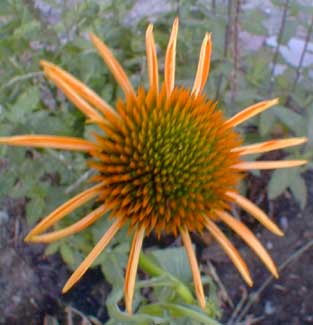
'Mango Meadowbrite'
Orange Coneflower
"There is no spot of ground, however arid, bare or ugly,
that cannot be tamed into such a state as may give an
impression of beauty & delight."
-Gertrude Jekyll
(1843-1932)
(1843-1932)
'Mango Meadowbrite' is a branch sport that arose from tissue-culturing the tangerine-colored 'Orange Meadowbrite,' the first echinacea introduced by the the Chicago Botanic Garden, indeed the first perennial of their entire ornamental plant breeding program (founded in 1996) to reach the marketplace, besides having been the first orange-petaled echinacea ever (with other shades of orange & yellow having followed, such as the Saul Brothers' creations 'Sundown' which is a peachy orange to magenta & 'Sunrise' which is a very pale citron yellow).
'Orange Meadowbrite' had darker color but it soon sunned out into a metalic pinkish purple, whereas the paler yellow 'Mango Meadowbrite' holds its shimmering color. It looks more like a Rudbeckia than a echinacea since the former is yellow & the latter ordinarily purple.
'Mango Meadowbrite' has neon-sheened golden-mango petals, surrounding a dark cone with shimmering orange-yellow cone-tips. It also has a mild citrus perfume. Increased scent for coneflowers is a recent development & 'Mango Meadowbrite' was at the vanguard of this trait for increasing numbers of recent cultivars.
'Mango Meadowbrite' is the trademark name developed for marketing purposes by Chicagoland Grows to which the Chicago Botanic Garden liscenses its best ornamentals. The official registration name is actually the unlovely 'CBG Cone3.' It was seven years in development by Dr. Jim Ault of the Botanic Garden, who was inspired by a monograph by Ronald McGregor published in 1968 in the Kansas Science Bulletin where it was first reported which species of echinicea would interbreed. It took thirty years for someone to follow-up on McGregor's research.
This & similar-colored varieties derive from crosses of the well-famed & most available & most highly adaptable Purple Coneflower (Echinacea purpurea) with the rarely seen wild yellow coneflower E. paradoxa native to dry glades of the Ozarks & prairies of Arkansas & Missouri.
Hardy in zones 4 through 9, on Puget Sound (Zone 8) it wants a full-sun location with sharply draining soil. It will need some attention its first year in the ground, but once established is extremely hardy for the xeriscape garden. It begins flowering late June or early July & with deadheading of spent blossoms continues flowering until first frost or later, minimally until September.
It grows to two & a half or three feet height, with an eventual clumping spread of two feet. Propagation is from cuttings, division, or commercially by tissue culture.
Continue to:
'Mac 'n' Cheese' Echinacea